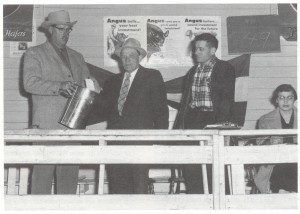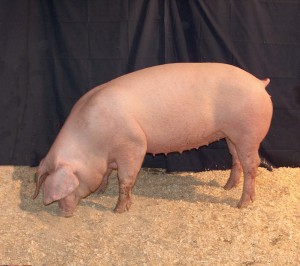The Lacombe hog, the only “made in Canada” pig, celebrates 50 years since its creation, although there are now not many of them around to crack open the champagne! Developed at the Lacombe Research Station, work on the new breed started in 1947 and was completed in 1958. The brainchild of Station Superintendent (later Director) Jack Stothart and geneticist Howard Fredeen, the Lacombe was bred from Danish Landrace, Berkshires from Britain and Chester Whites from the USA. “The intention was to produce a sire line that could be crossed with a Yorkshire sow to produce vigorous, fast-growing progeny with a good carcass,” explains Jurgen Preugschas of Five Lakes Farms, near Mayerthorpe, Alta., who, with his brother Walter, has 200 purebred Lacombes. “In those days, a pure Danish Landrace was used to cross with the Yorkshire, but they were not robust enough,” adds Alfred Wahl, General Manager of Peak Swine Genetics, which utilizes the Lacombe in its Trailblazer boar. “They needed a bacon pig, but without any colour, because bacon had the rind on in those days. Hardiness was also a key objective and that came from the Chester White breed.”
The three component breeds were crossed and back-crossed to form a pure composite breed, with selection being based on growth rate, litter size and carcass quality of 3-4 randomly selected littermates. Any pigs that had below average performance or had coloured skin were culled and these criteria led to 76% of all potential breeding stock being discarded. The resulting purebred Lacombe hog had 55% Landrace, 22% Chester White and 23% Berkshire genes.
 Based on the results obtained in field testing of the Lacombe when used for crossbreeding and also in purebred experimental herds at Scott, Indian Head, Olds and Vermilion, the advisory committee recommended release of the breed in 1957. Contract multiplier herds were then established, complete pedigree records were submitted to Canadian National Livestock Records and genetic purity for white colour was established. Also, Jack Stothart and Howard Fredeen developed a system of selective registration, based on minimum standards for growth rate, feed efficiency, and carcass merit. The Lacombe was the only breed to have this requirement, which provided proof of the pigs’ performance potential.
Based on the results obtained in field testing of the Lacombe when used for crossbreeding and also in purebred experimental herds at Scott, Indian Head, Olds and Vermilion, the advisory committee recommended release of the breed in 1957. Contract multiplier herds were then established, complete pedigree records were submitted to Canadian National Livestock Records and genetic purity for white colour was established. Also, Jack Stothart and Howard Fredeen developed a system of selective registration, based on minimum standards for growth rate, feed efficiency, and carcass merit. The Lacombe was the only breed to have this requirement, which provided proof of the pigs’ performance potential.
The first public exhibition of the Lacombe was made at the National Swine Show held in Brandon on July 1, 1957. This was followed on October 7th by a public draw to determine the recipients of the first 50 boars released. There were 823 applications and the successful producers came from right across Canada. Among these was Jurgen Preugschas’ father, Kurt, who had not previously been involved in producing purebred pigs. “You had to send in a submission explaining why you wanted to be a Lacombe breeder,” explains Jurgen Preugschas. “My father had been involved in breeding pigs, cattle and horses in Germany and his success in the draw gave him a start in swine breeding here in Canada.”
From 1958 onwards, breeding groups of Lacombes were released each year and, by 1960, 462 breeding females were in the hands of private breeders. “This new pig really only became available to breeders in 1958, so 2008 is its 50th anniversary,” notes Preugschas. The number of Lacombe pigs increased rapidly and by 1964 registration papers had been issued for 10,600 pigs. The 2326 Lacombes registered in that year accounted for 11% of all pedigree certificates issued.
 Results obtained in four years of field testing showed that the Lacombe produced carcasses equivalent in merit to the Yorkshire and had a 10% advantage in weaning weight and post-weaning growth rate. The only disadvantage of the breed seems to be its poor vision due to its floppy ears. “The Lacombes could not see fences and so would go straight through them!” exclaims Dr. Al Schaefer, Research Scientist at the Lacombe Station, whose father kept the breed. “Also, they seemed to have difficulty differentiating between the lying and dunging areas of their pen, which meant that were always dirty.”
Results obtained in four years of field testing showed that the Lacombe produced carcasses equivalent in merit to the Yorkshire and had a 10% advantage in weaning weight and post-weaning growth rate. The only disadvantage of the breed seems to be its poor vision due to its floppy ears. “The Lacombes could not see fences and so would go straight through them!” exclaims Dr. Al Schaefer, Research Scientist at the Lacombe Station, whose father kept the breed. “Also, they seemed to have difficulty differentiating between the lying and dunging areas of their pen, which meant that were always dirty.”
Whatever its advantages and disadvantages, the Lacombe has been eclipsed by the advent of large scale breeding companies and a focus on fewer pure breeds. The 200 Lacombes owned by Jurgen and Walter Preugschas are thought to account for the vast majority of the purebred pigs in the country. They are crossed with the Duroc to produce the Trailblazer boar, which is marketed by Peak Swine Genetics of Leduc, Alta. “The Trailblazer is a very vigorous F1 boar and is popular for natural service,” says Alfred Wahl. “However, what particularly interests us is the pork quality attributes of the Lacombe and we are currently carrying out gene evaluation on this. We want to take advantage of the meat quality attributes and this may result in a new lease of life for the breed”.
References:
Fredeen, H. T (1984) Lacombe Research Station, 1907 – 1982. Agriculture Canada Historical Series No. 18
Taylor, R. (1966) Lacombe Research Station serves large Alberta area for 60 years. Western Producer, December 1, 1966
Photo captions:
1. Lacombe gilt-1 – A purebred Lacombe gilt (photo courtesy Peak Swine Genetics)
2. Lacombe draw – The draw for the first breeding groups of Lacombe pigs, with Jack Stothart (far left) and Howard Fredeen (third left)









